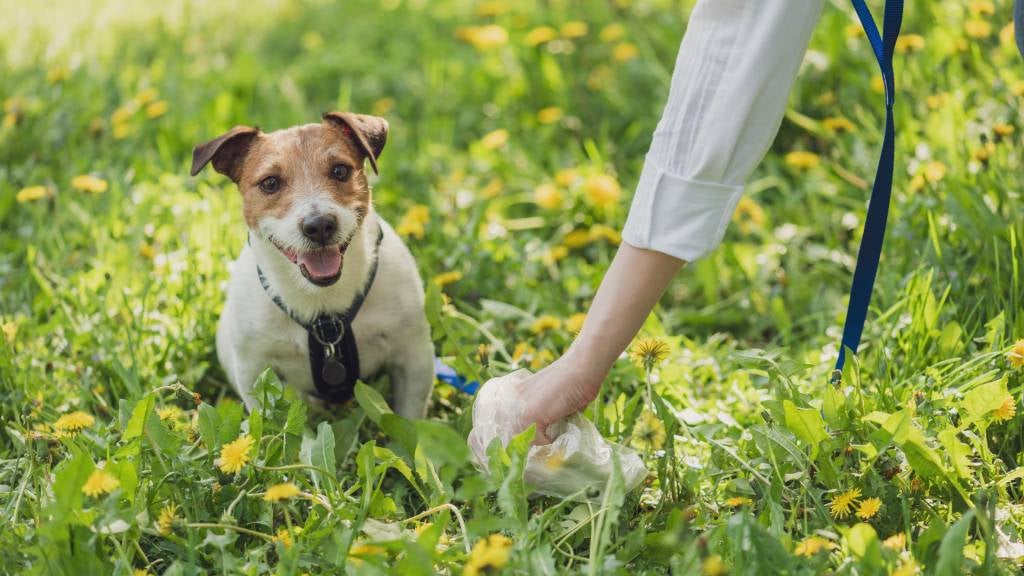What you need to know about puppy poo etiquette

Poop, number two…whatever you call it, picking it up is a must for any pet parent. Yes, even when no one is looking!
Dealing with poo is a necessary part of owning a dog, and with some basic etiquette and a bit of knowledge about what “the perfect poo” means, it can be easy to deal with in a way that’s safe for both you and your furry mates.
When you’re cleaning up, we encourage you to take a closer look since your puppy’s poo can tell you a lot about their health. While you may not want to inspect it too closely, knowing what to look for can help you to monitor your pooch’s health and recognise any underlying issues.
Puppy poo etiquette
Puppy poo etiquette may not be the first thing you think about when you look at your puppy.
But let’s face it; it happens and picking it up goes hand in hand with pet ownership and responsibility. Dog poop is not only messy, it is full of bacteria and may contain parasites and contribute to the spread of diseases.
Here are a few tips to make sure you’re being as responsible as possible, whether that’s on a walk, at the dog park or at a friend’s place:
- If you’re in a public space, keep an eye on your pup in case they decide to go. If they do, be sure to clean it up. The New Zealand Dog Control Act 1996 allows territorial authorities to pass bylaws that require “the owner of any dog that defecates in a public place or on land or premises other than that occupied by the owner to immediately remove the faeces.” As such, the laws may vary depending on your council area.
- If you’re at someone else's home be sure to come prepared with your own dog waste bag in case they go. Keep an eye on your pet so you can pick up any poo quickly, and we recommend you do a check of the lawn and home before you leave just to be safe.
- If you're out on a hike, bring along spare dog waste bags. Leaving droppings in natural areas can spread disease to native animals and harm the local ecosystem.
- Avoid burying it, even if you find yourself without a spare dog waste bag. This can be harmful to the environment and human health. If you find yourself in such a pickle, it’s best to ask other dog walkers if they have a spare bag, or if necessary, return to the spot later that day to pick it up and dispose of it correctly.
The trick is to be prepared. Always keep some dog waste bags with you, and don’t hesitate to use them. Using is just one part of the equation though, make sure you dispose of them responsibly in the correct bin.
The perfect poo
Since you’ve been picking up your dog's poo, most pet parents have a pretty good idea of what it usually looks like when they’re healthy.
Healthy droppings are firm and somewhat cylindrical in shape, and it should pass quickly and without straining. It’s usually a shade of brown that’s uniform in colour and without any streaks or lumps.
When we think in terms of frequency, most dogs go 1-5 times per day, but this can vary depending on how much they eat and also the quality of their diet.
Doggy diarrhoea
Diarrhoea is a typical digestive response to irritation or stress, which can have many causes. In most cases, it isn’t a serious problem and will resolve on its own within a few days.
However, if your furry friend has persistent or severe diarrhoea, it can lead to dehydration and other health problems. It’s also not as easy to pick up when you’re out and about and can leave some mess behind.
If your dog has diarrhoea, keep an eye out for the following signs:
- excessive straining or difficulty passing stool
- frequent bowel movements (more than 5 times per day)
- watery or bloody stool
- lethargy or weakness
- loss of appetite
If you spot any of the above signs, consult with your vet. The best way to treat it is to identify the underlying cause and address it accordingly.
Unusual poo and what it means
From unusual colours to weird consistencies, when you’re next picking up your pet's business don’t forget to take a look in case there’s something that may indicate a health issue.
- green – too much grass has been eaten or something much worse like parasites or eating rat poison
- orange – potential issues with the liver, bile duct or gallbladder
- red – could indicate blood within the lower end of the digestive system, a tumour or an injury
- black – bleeding in the upper part of the digestive tract, ulcers or medicines/poisons
- brown with white spots – possibly worms
- grey and greasy – could be pancreatitis, better known as maldigestion
- brown with mucus – inflammation in colon from dietary indigestion, stress, parasites or an infection
So, next time your pooch is doing their business, keep an eye on it. If your furry friend has problems, these tips can help point you in the right direction, but you may need further advice from your vet.
That's where SPCA Pet Insurance comes in. Coverage can help you pay for eligible treatments, which may include those related to your pup's potty habits.
14 Sep 2022